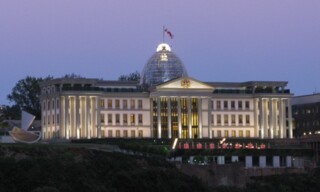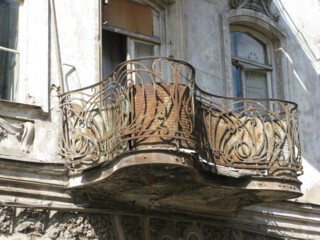In Tbilisi
Gillian Darley
I arrived in Tbilisi in the small hours of the night. (I was on my way to the Tusheti to go trekking, partly in aid of the Roddy Scott Foundation.) The road from the airport passes a blazing, undulating glass building. My taxi driver made me guess what it might be. Askating rink or art gallery, perhaps? But no, it was the new Interior Ministry and Police Headquarters, which, for all the symbolic transparency, has a solid, blocky core.
Next, on a hilltop dominating the Georgian capital, comes the Presidential Palace: a crude White House lookalike topped by a glazed dome borrowed from the modern Reichstag. Even at 4.30a.m. Mikheil Saakashvili’s official residence shimmers with superabundant power. Then, heading over theriver towards the Old Town, an exploding pea pod of twisted glass and metal, kinetically lit, comes into view: the Bridge of Peace. All three, designed and built between 2006 and 2010, are the workof an Italian architect, Michele de Lucchi.
In daylight, Tbilisi is revealed to be in need of urgent (but careful) repair and a reliable water supply. The city mixes unassuming vernacular buildings with substantial stuccoed mansions,embalmed during the Soviet years. Extravagant art nouveau houses, their febrile iron balconies clinging tenuously to crumbling façades, are a reminder that oil money once flooded in from Baku. Theso-called Lermontov House in Gudiashvili Square, with its fretwork balconies, has become the emblem of an increasingly desperate rearguard action to save the remnants of the town from the all-consuming alliance ofvoracious redevelopment and heavy-handed reconstruction.
This has been the best ever year for tourism in Georgia, as peace returns after the 2008 war with Russia.Saakashvili may not like old, but visitors, bringing in their much needed foreign currency, do. How to convince him and his compliant city officials that if the Old Town is razed to make way forglobal shopping outlets and brash reconstructed streets and squares that would disgrace a Hollywood film lot, they – we – may stop coming?


Comments
Plus from the point of view of your high-ranking-Georgian-official-who-asked-to-remain-anonymous, you get twice the kickbacks for tearing something down and then building something else there.